Better Workouts in Less Time
 Almost everyone is pressed for time these days, and squeezing a workout into your day is often not easy to do. However, it is possible to learn some ways of exercising more efficiently so you get a better workout in less time. Following are a few tips on getting the most out of your workouts.
Almost everyone is pressed for time these days, and squeezing a workout into your day is often not easy to do. However, it is possible to learn some ways of exercising more efficiently so you get a better workout in less time. Following are a few tips on getting the most out of your workouts.
Exercise both your upper and lower body at the same time – This allows you to not only save time, but also burn more calories. Use hand-held weights and pump your arms hard while running and walking, or use a rowing machine that causes you to give both upper and lower body a good workout.
Do high-intensity interval training – Researchers at McMaster University in Ontario, Canada, found that shorter but more intense workouts were far more effective than longer workouts of lower intensity. Professor Martin Gibala was the lead author of a two-week study that analyzed the workouts of healthy middle-aged men who performed six sessions of high-intensity interval training for 20 minutes each. Each session consisted of 10 intervals at 90 percent intensity lasting one minute each, with a minute of rest between each interval. The results matched or were better than those from participants who practiced traditional aerobic exercise for longer lengths of time.
Gibala says, “The participants showed dramatic improvement in their exercise capacity. Before, maybe they could ride a bike pretty intensely for 25 minutes. After those two weeks, they could ride it for 50 minutes.” Some exercises that lend themselves well to this type of training are the elliptical machine, rowing machine, bicycling and sprinting. Do one minute of intense exercise at 90 percent of your capacity for one minute, then rest for one minute. Repeat this sequence ten times for a 20-minute workout and you’re done!
Vary your workouts – Studies have shown that the body becomes more efficient at a particular type of exercise if it is done repeatedly, so if you want to burn more calories, vary the exercises you do. Physical trainer Dino Novak says, “When the body is doing a set rhythm, it expends less energy than when it’s forced into multiple movements.” He advises, “For example, instead of just going for a run, do sprints — and then stop, start, turn, twist. Add motion and movement into your activity and you’ll literally keep your body expending the maximum energy.”
Listen to fast music – According to the results of a study performed by scientists at the Research Institute for Sport and Exercise Sciences, subjects who listened to fast music while working out pedaled an exercise bicycle faster and achieved a faster heart rate than when they listened to slow music. So crank up the tunes!
The Latest on Motorcycle Safety Gear
 There are few more iconic images than that of the motorcyclist. Whether it’s zipping through traffic when cars are at a standstill or exploring long, winding country highways, motorcycling is many people’s idea of bliss. In order to keep enjoying that bliss, however, it’s necessary to add a dash of caution and common sense. According to statistics from the U.S. Department of Transportation’s National Highway Traffic Safety Administration (NHTSA), motorcyclists are 35 times more likely to experience a deadly road accident than those traveling in passenger vehicles. Even the most skilled motorcyclists need motorcycle safety gear to protect themselves against injury. Remember-more often than not, motorcycle accidents are the fault of people driving other (larger) types of vehicles…
There are few more iconic images than that of the motorcyclist. Whether it’s zipping through traffic when cars are at a standstill or exploring long, winding country highways, motorcycling is many people’s idea of bliss. In order to keep enjoying that bliss, however, it’s necessary to add a dash of caution and common sense. According to statistics from the U.S. Department of Transportation’s National Highway Traffic Safety Administration (NHTSA), motorcyclists are 35 times more likely to experience a deadly road accident than those traveling in passenger vehicles. Even the most skilled motorcyclists need motorcycle safety gear to protect themselves against injury. Remember-more often than not, motorcycle accidents are the fault of people driving other (larger) types of vehicles…
The head, arms and legs are the areas of the body most likely to sustain injury in a motorcycle accident, so protect these first and foremost. The basics of protective clothing include jackets and pants (or a suit), gloves, boots, and of course a helmet. Jackets, pants and gloves can be constructed from leather, nylon or Kevlar. The best quality leather is made from cowhide, as it is the most durable. You can also find pigskin leather that may look nice and be less expensive, but it is far more easily damaged. Be sure the leather is a minimum of one millimeter in thickness for optimal protection. Buffalo hide is another good choice if you can find it.
Many people prefer synthetic materials, due to what some feel is greater comfort and improved weather protection. Whether you choose nylon or Kevlar, test the material to see if it can stretch and breathe. This is important when biking on a hot day. It should also be strong and durable enough to be able to maintain its integrity in the event of an accident.
When choosing a motorcycle jacket, ensure that the stitching at your joints (elbows and shoulders) is strong and preferably reinforced. A well-made jacket will have extra padding in the area of the spine, elbows and shoulders. A jacket of man-made materials should have reflective stripes. Your jacket should fit snugly without being too tight. It should allow for extra layers underneath if you are a cool-weather biker. When trying it on, be sure to also sit in it in riding position to ensure that your back and wrists remain covered while in that position.
Although jeans may be more comfortable, leather pants or chaps are always recommended. In addition to providing greater protection, chaps or insulated pants may be specially coated for water resistance, which is an added bonus in bad weather that jeans just can’t match.
The best gloves (which should be worn at all times, no matter what the weather) will have knuckle protection made from carbon fiber. Cold weather gloves are essentially the same, but with insulation – and often waterproofing – included.
Boots should be at least 6 inches in height to offer ankle protection, and sport a slip-resistant sole. Thicker soles are better at absorbing bike vibrations. Leather boots are always preferable to nylon running shoes, which offer no protection to your feet and ankles in case of an accident.
The use of brightly colored, reflective clothing has been shown to reduce the risk of road accidents by 37%. If your clothing does not have reflectivity built-in, you can add it with the addition of reflective tape kits. Anything that makes you more visible to other drivers can dramatically decrease your risk of an injury.
Although nobody enjoys wearing a motorcycle helmet, it may make the difference between life and death (or between life and living in a vegetative state). A good helmet will have a Department of Transportation (DOT) certification sticker on the back. This ensures that the helmet meets stringent safety requirements. You will get the most protection from a full coverage helmet that covers the entire head and face, with a clear acrylic visor for added protection against insects and various light road debris. Many helmets also feature vents to help keep your head cool.
A well-equipped biker is a happy, healthy one, so buy some quality gear and get out there to enjoy the open road!
Chiropractic and Addiction
 It is ironic that chiropractic-a health care methodology that is committed to being drug-free-is being utilized more and more as an effective treatment for the ravages of addiction. Addiction is a major public health problem these days, with the National Institutes for Health (NIH) estimating that 15% of Americans can be classified as “problem drinkers” or alcoholics, and that 1 in 10 Americans are either addicted to or in recovery from the use of illegal drugs. And the problem of drug addiction is far from being limited to illegal drugs; the National Institute on Drug Abuse estimates that millions of Americans meet abuse or dependence criteria for prescription opioids and painkillers used to treat their chronic pain. Add to alcohol and drugs other mainstream sources of addiction (smoking and gambling for example), and it becomes quite clear that addiction is a broad problem that negatively affects the lives of those addicted and their families as well as society at large.
It is ironic that chiropractic-a health care methodology that is committed to being drug-free-is being utilized more and more as an effective treatment for the ravages of addiction. Addiction is a major public health problem these days, with the National Institutes for Health (NIH) estimating that 15% of Americans can be classified as “problem drinkers” or alcoholics, and that 1 in 10 Americans are either addicted to or in recovery from the use of illegal drugs. And the problem of drug addiction is far from being limited to illegal drugs; the National Institute on Drug Abuse estimates that millions of Americans meet abuse or dependence criteria for prescription opioids and painkillers used to treat their chronic pain. Add to alcohol and drugs other mainstream sources of addiction (smoking and gambling for example), and it becomes quite clear that addiction is a broad problem that negatively affects the lives of those addicted and their families as well as society at large.
Let’s talk for a minute just about substance abuse. Whether the source of the addiction is alcohol, illegal drugs or prescription drugs the reasons people have for taking them in the first place are remarkably consistent, and based on feelings of dis-ease. People are in such pain – physical pain as the result of injury or disease, or emotional pain as the result of psychological trauma or mental illness – that they turn to these addictive substances to dull their ever-present pain and just “get through the day.” And while there are conditions for which powerful opioid painkillers can be legitimately prescribed, the continued use of them can be as debilitating as the illegal drugs, and can wreak havoc on people’s overall physical and mental health.
Chiropractic care is increasingly being shown to be remarkably effective at eliminating the dependency that such individuals have on these addictive substances, and at helping them to live alcohol- and drug-free lives. Chiropractic does this by often eliminating some or all of the chronic pain that caused the person to resort to drugs or alcohol in the first place, easing the levels of physical aches and pains that cause a person to crave prescription medication or seek to self-medicate.
But because chiropractic care is above all holistic and designed to improve all aspects of a person’s life simultaneously, chiropractic treatment can also relieve psychological pain and mental distress, and enable people to re-achieve a sense of well-being. On a physical level, the spinal adjustment received during chiropractic care have been shown to release endorphins and other “feel good” chemicals in the brain, and thus to directly improve the sense of well-being. When the spine is in proper alignment, powerful chemicals known as neurotransmitters are released in their intended order and amount, resulting in positive mental states. One recent study published in the journal Medical Psychiatry found that when a 30-day addiction recovery program was supplemented with frequent chiropractic adjustments, the subjects achieved an unprecedented 100% success rate with the program.
Chiropractic care is safe, effective, and long-lasting, helping people’s bodies to heal in a holistic manner. Having this alternative means that they don’t need to resort to the use of prescription drugs, alcohol or illegal drugs to suppress their pain and feelings of dis-ease. So if you or someone you know and love is struggling with addiction issues of any kind, please look into the benefits that professional chiropractic care could bring to their recovery.
Obesity Facts and Figures
Obesity is fast becoming the number one health problem in the world, contributing to an increased risk of other diseases and putting a strain on national health budgets. Following are some interesting facts and figures related to obesity:
* About 17% of medical costs in the US are due to obesity and its related diseases, totaling an estimated $168 billion per year.
* Obesity adds about $2,800 to a person’s medical bills annually.
* An estimated 300,000 premature deaths in the US each year are caused by obesity.
* One third of US adults are obese, indicating a body mass index (BMI) of 30 or higher.
* If an 18-year-old remains obese throughout their adulthood, it will cost them $550,000.
* 80% of cases of Type 2 diabetes are related to obesity. The rate of diabetes has doubled in eight states since 1995.
* 70% of heart disease is obesity-related.
* Low-income women are more likely to become obese than high-income women. Over 33% of people earning less than $15,000 annually are obese, as opposed to a 24.6% rate of obesity in those earning $50,000 or more.
* The highest rates of obesity are found among non-Hispanic African Americans (44.1%), followed by Mexican-Americans (39.3%), Hispanics (37.9%) and non-Hispanic whites (32.6%). Asians have the lowest rate of obesity at 16.7%.
* In the last 30 years childhood obesity has tripled, from 6.5% in children aged 6 to 11 years to 19.6% today. The obesity rate in teenagers aged 12 to 19 years has increased from 5% to 18.1%.
* Of children who are overweight at age 10-15, 80% will be obese as adults.
* As a percentage of the population, the US has the highest number of obese people (33.9%), followed by Mexico (24%), the UK (23%), Slovakia (22.4) and Greece (22%).
* College graduates have an obesity rate of 20.8%, which is lower than the 29.5% rate of those who have only graduated high school.
* Obesity begins to decline after age 60. The population of those over age 69 has an obesity rate of 20.5%.
* The rate of obesity is increasing in the US. In 2007 only one state had an overall obesity rate of over 30%. In 2011, 12 states had a greater than 30% obesity rate.
* 40% of obese Americans aged 50 to 84 have osteoarthritis of the knee, caused by the wear and tear to the joints from excess weight stress. One extra pound of weight is equivalent to four pounds of stress on the knee.
Good health is a combination of many factors including your nutrition, preventative care, appropriate corrective care and the small choices you make every day in the course of living.
If you are overweight and would like to lose weight and/or learn more about how to eat for health and weight maintenance we can help! Our doctor supervised diet helps you safely lose weight while maintaining muscle mass. As a bonus, with the help of our weight loss coaches, you will learn nutritional and lifestyle skills that will serve you well for a lifetime! For more information, call our office at 406-652-3553 or go to www.healthyhabitsbillings.com.
If you have questions about this article, your general or spinal health, please ask. We are here to help!
Preparing For the Holidays
 As we approach the holidays we want to focus on presence. That isn’t a typo. I’m referring to presence as in a state of being, rather than the typical presents that we think of this time of year which come wrapped up in fancy paper. If you are like most people you probably can’t remember the long list of gifts you’ve received over the years. While we appreciate the gifts and the people who gave them to us, most of those gifts get lost in the shuffle with all the other stuff we accumulate over time.
As we approach the holidays we want to focus on presence. That isn’t a typo. I’m referring to presence as in a state of being, rather than the typical presents that we think of this time of year which come wrapped up in fancy paper. If you are like most people you probably can’t remember the long list of gifts you’ve received over the years. While we appreciate the gifts and the people who gave them to us, most of those gifts get lost in the shuffle with all the other stuff we accumulate over time.
However, can you remember a gift that did have a long lasting impact on you, either because it was something that you truly wanted or needed or it had deep personal significance? When you think of that gift does it remind you of the person who gave it to you? The true gift is the presence of the people that we love and that love us. Think about times in your life that you shared with someone special and what that time together means to you. Then take a look at your life now and the people in it. Are you doing what it takes to create those special moments with the people you care about in your life?
In our fast-paced society it is easy to lose track of the things that are most important, the things that are going to mean something when our eulogy is being read. People often throw out the phrase, ‘It’s the quality of the time that matters, not the quantity’. Wrong, it’s both.
You can spend all kinds of time with someone and never have a meaningful exchange. On the other hand, you can have some great moments that stand out as the exceptions to the rules of the relationships in your life. I suggest that we should try to combine quality and quantity and create truly meaningful relationships in our lives.
“The most precious gift we can offer others is our presence. When mindfulness embraces those we love, they will bloom like flowers”~ Thich Nhat Hanh
Take this opportunity to evaluate your relationships. If you find that you are not doing all you can to nourish those relationships, recommit to improving the quality and quantity of the time you invest in them. This year and going forward, make your presence your present.
Cooking With Coconut Oil
 Coconut oil should be a staple in the kitchen of any health conscious cook.
Coconut oil should be a staple in the kitchen of any health conscious cook.
The benefits of coconut oil are far and wide. One of the best features is that coconut oil has a high melting point. This helps it to hold up to the high temperatures of cooking where other oils become rancid. During the cooking process other oils can become toxic.
Not only does coconut oil hold up to cooking, its unique molecular structure offers nutritional benefits not found in other oils. Almost half of the fat in coconut oil is called lauric acid. Lauric acid is not found in many other places in nature. Once metabolized in the body, lauric acid is converted into monolaurin which has anti-microbial, anti-viral, and anti-fungal properties. This makes coconut oil a great friend to your immune system.
Coconut oil is also a rich source of medium chain fatty acids. Unlike long chain fatty acids, MCFA are easily digested and metabolized in the liver to produce energy. This makes it an ideal food for endurance athletes or anyone concerned about their weight or blood sugar. Since it is a fat and not a carbohydrate, you avoid the spike in blood sugar that is often followed by a crash in energy as the body works to balance the blood sugars and insulin levels.
With the increase in popularity of coconut oil in recent years you can find it in almost any grocery store. I encourage you to give it a try. For those of you who don’t like coconut, the flavor of the oil is relatively mild and is usually overpowered by the flavors of the other ingredients you are cooking with.
Bon appetite.
An Apple A Day

The old saying, “An apple a day keeps the doctor away” comes from an old English adage, “To eat an apple before going to bed will make the doctor beg his bread.” While this may not be completely true, a regular dose of apples in your diet is a good choice.
As we approach fall apple orchards across the country are preparing for the fall harvest. Most people have a favorite apple variety and with 100 commercially grown varieties in the U.S. there is no shortage of options. Apples are a diverse fruit found around the world and are packed with nutrients and fiber.
Nutritionally, apples are an all star. Vitamins A, C, E, K and B are all found in apples. Minerals, electrolytes, and phytonutrients are also abundant in apples. Apples contain no sodium, fat, or cholesterol and for a medium-sized apple you are looking at about 80 calories. So as you can see it really is a great choice for anyone that is conscientious about what they eat.
For the maximum benefit eat your apples raw with the skin. The skin of the apple is where you will find your highest concentration of fiber and nutrients. I recommend that you eat organically grown fruit whenever possible, but if that is not an option, apples are a fruit that can be easily washed. You don’t want to offset the benefits of the apple with the harmful effects of chemicals that may have been sprayed on the fruit.
Finally, if where you live allows it, take advantage of the fall weather and the apple harvest, pile into the car and go apple picking. Many orchards allow you to pick your own apples and often have special events throughout the fall to draw people in. Make an afternoon of it. Enjoying the sunshine with loved ones, walking around the orchard in the fresh fall air, and of course eating the fruits of your labor, makes for a well rounded day of health and wellness. If you don’t live in a region where you can pick apples, still make a day of it. Pack a picnic with your favorite food, including apples, and take a trip that includes a nice outdoor hike and picnic! How do you like them apples?
Vitamin D
 In recent years a lot of attention has been given to Vitamin D. Doctors have known for years that it is necessary for strong bones. Vitamin D is required for the body to assimilate calcium into our bones. The lack of Vitamin D can cause weak bones called Rickets. Low levels of Vitamin D have also been found to be associated with cardiovascular disease, cognitive impairment in adults, asthma, cancer, and a weakened immune response.
In recent years a lot of attention has been given to Vitamin D. Doctors have known for years that it is necessary for strong bones. Vitamin D is required for the body to assimilate calcium into our bones. The lack of Vitamin D can cause weak bones called Rickets. Low levels of Vitamin D have also been found to be associated with cardiovascular disease, cognitive impairment in adults, asthma, cancer, and a weakened immune response.
There are various reasons why someone may become Vitamin D deficient. Because the body requires exposure of the skin to activate Vitamin D, geography often plays a role in Vitamin D deficiency. People living in Northern latitudes are exposed to less sunlight and are at a greater risk. Having dark skin or using sunscreens can diminish Vitamin D levels, and digestive issues such as Crohn’s Disease can prevent the absorption of Vitamin D from food sources. Being obese is another factor because Vitamin D, being a fat soluble vitamin, can get trapped in our own fat cells where the body doesn’t have access to it.
The following excerpt was taken from a recent article in Natural News about Vitamin D:
(NaturalNews) A new study published this month finds that the hormonally active form of vitamin D, Calcitriol 1,25-dihydroxyvitamin D(3), inhibits the growth of many kinds of cancerous cells, including breast cancer, indicating that vitamin D3 can be useful in treating and even preventing a variety of cancers. Authors of the study said that caner cell growth is inhibited by “anticancer actions including cell cycle arrest, promotion of apoptosis and inhibition of invasion, metastasis, and angiogenesis.” Vitamin D’s anti-inflammatory properties and interference with estrogen synthesis further explains its anti-tumor properties.
Learn more: http://www.naturalnews.com/036597_vitamin_D_anti-cancer_drug.html#ixzz23dQNKNbv
If you are concerned about your Vitamin D level it can be tested with a simple blood test. A healthy level is considered to be at least 50 ng/mL. Some sources disagree as to what is considered a healthy range, so it is valuable to get the exact number rather than just a report of normal. Levels below 50 ng/mL may require supplementation and/or increasing your exposure to sunlight.
Recommended Daily Allowance of Vitamin D is between 600-1000 IU/day. If you are deficient you can use a supplement, increase your intake of Vitamin D containing foods, and increase your exposure to sunlight. If you increase your exposure to sunlight do some research first so that you do it safely without getting burned. If you choose to supplement, seek out a high quality whole food supplement. As far as food goes, the best sources are from fish like sardines and salmon. Other foods like milk are fortified with Vitamin D.
The Skinny on Fats
 Years ago fats got a bad name in nutrition. As a result, food manufacturers started taking out the fat, but in order to make the food palatable they had to enhance the flavor with sweeteners, which created a whole different set of problems. Now people are gaining a better understanding about fats and are realizing that not all fats are created equal and fats are even essential to a healthy diet.
Years ago fats got a bad name in nutrition. As a result, food manufacturers started taking out the fat, but in order to make the food palatable they had to enhance the flavor with sweeteners, which created a whole different set of problems. Now people are gaining a better understanding about fats and are realizing that not all fats are created equal and fats are even essential to a healthy diet.
Fats are necessary for many biological processes. Fats provide energy and are necessary for the absorption and assimilation of many vitamins. Omega-3 fatty acid is a good example of a fat known to have many health benefits such as being an anti-inflammatory.
You will find that there are a lot of terms associated with fats such as saturated, unsaturated, trans and so on. All these terms describe the chemical composition of the fat but can be confusing for the newly health conscious consumer. While these are not hard and fast rules, these suggestions will get you started towards helping you gain some understanding about this complex subject. Let’s keep it simple to start and you can use this to build on as you learn more about nutrition.
Generally speaking unsaturated fats are going to be the healthier fats. You may see the prefix Poly or Mono in front, which is fine. Unsaturated fats generally come from plant sources and tend to be a liquid at room temperature.
Saturated fats are a bit complex and not clear cut as to whether they are healthy or not. Saturated fats come from animal sources and things like coconut oil. We know that coconut oil has many health benefits but there is disagreement about the nutritional value of animal fats.
However, trans fats are considered unhealthy. trans fats have been chemically altered to make them more stable. Look for terms such as hydrogenated or partially hydrogenated. This is a chemical process used to extend the shelf life of many products. Products such as shortening are good examples of trans fats.
As I stated earlier, this is a complex subject with many exceptions to the rules. If you would like to learn more about this topic I suggest the book Good Calories, Bad Calories. This book will help you get The Skinny on Fat.

